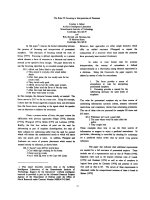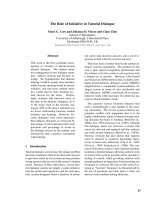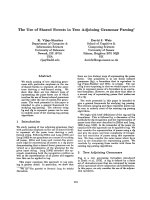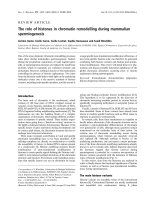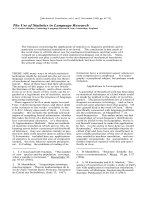Báo cáo khoa học: "The Use of Statistics in Language Research" docx
Bạn đang xem bản rút gọn của tài liệu. Xem và tải ngay bản đầy đủ của tài liệu tại đây (149.07 KB, 7 trang )
[
Mechanical Translation
, vol.5, no.2, November 1958; pp. 67-73]
The Use of Statistics in Language Research
A. F. Parker-Rhodes, Cambridge Language Research Unit, Cambridge, England
The literature concerning the application of statistics to linguistic problems and in
particular to mechanical translation is reviewed. The conclusion is that much of
the work done is of little direct use for mechanical translation, and that some of it
is based on a misapprehension of what statistical techniques can in fact do. Statis-
tical methods can play a useful part in the development of mechanical translation
procedures once these have been well established, but have little to contribute at
the present stage of the work.
THERE ARE many ways in which statistical
techniques might be pressed into the service of
language research, and in particular the theory
of mechanical translation and information re-
trieval. Most of these have had their advocates,
The purpose of this paper is to review briefly
the literature of the subject, and to draw conclu-
sions as to how much of this work can be re-
garded as a legitimate use of statistics, and as
to how relevant it is to the progress of language-
processing technology.
There appear to be five main topics covered.
First, I shall enumerate these, and then I shall
refer seriatim to the works available in the
C.L.R.U. library upon each of them. 1) Lexi-
cography: this includes the methods and tech-
niques of compiling lexical information, whether
this takes the form of a dictionary of a more or
less conventional character, or a thesaurus.
2)
Approximative Methods: these are methods
of machine translation which aim to rely on
keeping errors below a preconceived threshold
of tolerance; they use statistics mainly to pre-
dict how little work need be done to achieve this.
3)
Economics: included here are applications
of statistics to ascertain the size of computers
needed, the time taken to operate programs,
etc. 4) Coding: the problems of coding of in-
formation have a statistical aspect whenever
code-compression is employed. 5) Crypto-
graphy: a peripheral subject, but perhaps worth
inclusion.
Applications to Lexicography
A good deal of theoretical work has been done
on statistical techniques of a kind which could
or might be applied to the study of word fre-
quency. The general problems are of a kind of
frequent occurrence in biology, and so have
received some attention from that quarter. Of
this general kind is the work of Good.
1
More
specifically concerned with language problems
are the contributions of Mandelbrot
2,3
on
word-frequencies. This author points out that
a knowledge of word-frequency distributions
could be useful to the lexicographer, but he is
not himself concerned to make this application.
In fact, no one seems to have done so, except
Koutsoudas,
4
who in fact concludes that the so-
called Zipf and Joos laws are insufficient to
give reliable predictions of the size of diction-
aries needed in machine translation, and con-
sequently recommends the accumulation of
further empirical material with this end speci-
fically in view.
1.
I. J. Good and G.H.Toulmin, "The number
of new species and the population coverage,
when a sample is increased, " Biometrika, 43,
pp. 45-63 (1956).
2.
B. Mandelbrot, "Linguistique statistique
macroscopique: Theorie mathematique de la
loi de Zipf," Institut Henri Poincare, Seminaire
de Calcul des Probabilites, (June 13, 1957).
3.
B. Mandelbrot, "Structure formelle des
textes et communication," Word, 10, pp. 1-27
(1954).
4.
A. M.Koutsoudas and R.E. Machol, "Fre-
quency of occurrence of words; a study of Zipf's
law with application to mechanical translation, "
University of Michigan, Engineering Research
Institute, Publication 2144-147-T (1957).
68 A.F.Parker-Rhodes
Koutsoudas' statistical techniques are appar-
ently adequate for his purpose, and he has com-
piled the required data and analyzed them. No
one else has apparently taken statistical meth-
ods as seriously as this, and most references
to the subject merely suggest that an applica-
tion of statistics to dictionary making should be
made,
5
or even in one case that no dictionary
could be made without previous statistical
analysis.
6
The use which most of these authors have in
mind is to find out how large a dictionary must
be in order to contain, with a given fiducial
probability, all the words of particular kinds
of text. A secondary application is in finding
some way of arranging the entries of a diction-
ary which will reduce searching time by making
the most frequent words come up before the
less frequent ones. Much more sophisticated
is the idea behind compiling a thesaurus. In a
thesaurus we have not merely a list of words
with coded information upon them, but a mathe-
matical system whose elements represent sets
of words, so arranged that, ideally, every word
in the system can be defined by listing the sets
in which it occurs. If this were done properly,
it should be possible to find a word, or at least
most words, by specifying not all the sets in
which it occurs, but only some of them; thus,
it might be possible to specify a set of sets by
considering the context of a given word, as well
as itself, which would be enough to identify the
given word as exactly as we might wish, pro-
vided our thesaurus contained enough informa-
tion suitably organized.
Obviously, the success of such a scheme is a
matter which could be statistically assessed,
and in some measure no doubt statistically pre-
dicted. Thus, those who have considered the
use of a thesaurus in MT have not been slow to
appeal to statisticians for help in the very con-
siderable labor of compilation involved. How-
ever, in fact, they have not progressed very
far. As Luhn
7
puts it, "the formation of no-
tational families (his name for thesaurus heads)
is a major intellectual effort, to be undertaken
by experts familiar with
the special field
5.
N. Chomsky, Syntactic Structures, Mou-
ton and Company, The Hague (1957).
6.
V.A.Oswald and S.L.Fletcher, "Proposals
for the mechanical resolution of German syntax
patterns," Modern Language Forum, vol. 36,
no. 3-4.
of the subject-literature." This major effort
has to be done before one can begin to apply
one's statistical methods; Luhn himself makes
no pretence of actually doing any statistics. On
the other hand Gould,
8
who also considers the-
saurus methods, presents the appearance of
statistical computation. His problem is the
translation of Russian mathematical texts into
English, and he is concerned to assess the mag-
nitude of the problem of 'multiple meaning' by
statistical means. He defines an 'index of mul-
tiplicity' in algebraic formulae, and evaluates
it for various word-classes (according to the
system of Fries
9
), and presents numerical
tables of the result. Actually the figures are not
statistical in the strict sense, since no signifi-
cance tests are done (nor is it shown that his
index is a sufficient statistic), and the tables
only show such facts as, for example, that
prepositions are particularly liable to have
multiple meanings. It cannot therefore be said
that Gould's use of figures has added to what a
discursive argument could have more lucidly
put across.
One must conclude, from the few attempts
which have been made actually to use statistics
for lexicographic purposes, that in this field, a
valid application exists only after the lexico-
graphic data have been compiled. The same is
true, whether the compilation takes the form of
a dictionary or a thesaurus. Given these data,
one can assess its adequacy, and even propose
specific improvements of a major or minor
kind, as a result of statistical analysis of its
performance. But before the lexicographer
has done his work, the statistician has nothing
to use as data.
Approximative Methods
One answer to the difficulties raised by the
attempt to reduce translation to a mathemati-
cally definite procedure is to base one's proce-
dure on the opposite conception, namely that
7.
H. P. Luhn, "A statistical approach to mech-
anized encoding and searching of literary in-
formation, " IBM Journal of Research and De-
velopment, vol.1, no.4, pp. 309-317 (Oct. 1957).
8.
R.Gould, "Multiple correspondence," MT,
vol. 4, no. 1/2, pp. 14-27 (Nov. 1957).
9.
C. C. Fries, The Structure of English,
Harcourt, Brace and Company, New York (1952).
Statistics in Language Research 69
that instead of mathematical definiteness one
should aim at acceptable approximation to the
best that a human translator can do. In that
case, it becomes important to know how much
work must be directed to removing the errors
present in too crude a procedure, in order to
reduce the remaining errors to a point below
some given threshold of tolerance. This is a
statistical problem familiar in industry and in
military applications. There seems good rea-
son to expect that, if the approximative approach
to MT is accepted as a useful one, it will rest
largely on a statistical foundation.
A good example of the kind of work which is
relevant to this viewpoint is that of Yngve
10
on
'gap analysis'; even though this is not oriented
directly to MT application. This aims to sup-
plement syntactic analysis of a text by a statis-
tical procedure designed to reveal discontinu-
ities between pattern-groups (of words) previ-
ously established by analysis of a sufficiently
large corpus of texts. Insofar as the results
of such analysis can be regarded as an accept-
able model of actual linguistic analysis, the
procedure is perfectly sound and, it must be
admitted, highly ingenious. It is not like the
deceptive figuring which we sometimes meet
under the guise of statistics in language re-
search. Most often, however, approximative
methods are directed to eliminating errors of
a lexicographic kind. For example, Glazer
11
has tried to work out the statistics necessary
to permit the insertion of English articles into
a translation from the Russian. He makes no
great claims for the result but it is at least
apparent from his work that the amount and
detail of the statistical information required to
'solve' this problem, even within the frame-
work of the approximationist philosophy, would
be very considerable. In fact, it is unclear
why it should be supposed any 'easier' than
using real linguistics to do the job.
A better case is made out by King and Wiesel-
man,
12
who have made some useful estimates
of the work involved in progressively improving
a crude translation by replacing more probable
(and thus sooner tried) renderings of a given
word or phrase by successively less probable
ones. Once again, the conclusion seems to be
that an acceptable amount of computation work
leads to a still unacceptably erroneous result,
though this no doubt depends on the purpose
governing our choice of method.
The nature of approximative methods of trans
lation is seen at its clearest when the attempt
is made to get at the true meaning of a word by
comparing it with successively wider areas of
'context.' The idea is that if the word itself
is not sufficiently determinate to be translated
by one-one equivalence, it may be that compar-
ing it with the next word, or the last word, will
suffice to reduce its possible equivalents to one
failing that, we try two neighboring words, and
so on till the desired result is achieved. This
of course is a very crude model of what context
really is, and, as I have stated it, depends on
the untenable view that each word has a definite
number of 'meanings', one of which has to be
selected as its translation in the given context.
These are just the assumptions made by
Kaplan,
13
who made a statistical study of the
problem; he collected his data by asking human
informants to write down how many 'meanings'
of selected words occurred to them, when the
said words were presented in company with var
ying numbers of neighboring words. His con-
clusions were not very detailed, largely becaus
his informants were too few to provide a really
adequate sample, but they showed clearly enough
that indeterminacy of meaning was a decreasing
function of size of context. There would be
scope for a similar study, on a larger scale
and with more powerful statistical methods,
using a realistic model of what constitutes
context and a realistic measure of the indeter-
minacy of semantic content; this would however
be difficult to do. Like most applications of
statistics to MT it would only really give use-
ful results when applied to an already mecha-
nized translation procedure. It would be far
too slow and laborious to constitute an aid to
constructing a mechanized procedure.
10.
V. H. Yngve, "Gap analysis and syntax,"
Transactions IRE, vol.IT-2, no. 3, pp. 106-112.
11.
S. Glazer, "Article requirements of plural
nouns in Russian chemistry texts," Georgetown
University, Institute of Languages and Linguis-
tics, Seminar Work Paper MT. 42 (1957).
12.
G. W. King and I. L. Wieselmann, "Sto-
chastic methods of mechanical translation,"
MT, vol. 3, no. 2, pp. 38-39 (Nov. 1956).
13.
A. Kaplan, "An experimental study of am-
biguity and context," MT, vol. 2, no.
2,
pp.
39-46 (Nov. 1955).
70 A. F. Parker-Rhodes
Application to the Economics of
Language Processing
It may be objected that it is still much too
early to embark on a serious study of the eco-
nomic aspects of MT. It is necessary, how-
ever, from time to time to reassure those con-
cerned that the scale of the enterprise is not
wholly disproportionate to the sums which its
ultimate users will be prepared to devote to the
necessary equipment. It can hardly be said that
adequate data yet exist on which to base an in-
formed answer to the question, "How big a
computer must one have to do mechanical trans-
lation properly?" The question is of course a
statistical one and in this sense is relevant to
the present enquiry but it need not detain us
long. Several workers have referred to the
problem, but only Yngve
14
has given any de-
tailed estimates. Their worth is somewhat de-
pendent on accepting a particular view of the
nature of the MT procedure but may be accepted
to an order of magnitude, at least until more
substantial data are available.
Coding and Code Compression
In large measure the coding problems arising
in MT and in library work are the same as
those occurring in other branches of communi-
cation engineering. The need for code compres-
sion perhaps arises more urgently in MT, be-
cause of the great bulk of the material to be
stored, but the mathematical problems it pre-
sents are the same as in other fields, except
where, as in the use of thesaurus methods, the
mathematical structure of the information to be
coded imposes special restrictions.
I do not intend to refer to the already con-
siderable literature on code compression.
Specific applications to MT have been dis-
cussed by Mooers.
15
This work however de-
pends on using a tree-type semantic classifica-
tion, as has hitherto been done in most informa-
tion retrieval systems. The statistics of the
process would be appreciably different in a
lattice system.
14.
V. H. Yngve, "The technical feasibility of
translating languages by machine," Transac-
tions AIEE, Paper 56-928 (1956).
15.
C. N. Mooers, "Zatocoding and develop-
ments in information retrieval," Aslib Pro-
ceedings, vol. 8, pp. 3-19 (1956).
Less specific to our immediate subject are
the methods, many of them well known, for
compressing alphabetic codes. Quite powerful
methods are possible here because of the very
great redundancy in alphabetic writing. They
are discussed, in general terms and without
statistical analysis, by Mukhin
16
and Panov.
17
In general it may be said that none of this work
is either controversial or novel; but the statis-
tics of code compression in thesaurus systems
is still (as far as published work goes) an un-
explored field.
Cryptography
As for coding problems, there is a large lit-
erature on cryptography and code design which
I do not intend to explore. There are however
some special points of contact between crypto-
graphy and language research in which statistics
could play a part. Yngve
18
has written an in-
teresting paper in which he treats of the trans-
lation problem (especially translation out of un-
known languages) as a special case of the prob-
lem of decoding a message without the advantage
of a complete code-book to do so. The ap-
proach potentially involves the use of statis-
tics, and, while Yngve does not carry the anal-
ysis far enough to make actual calculations it
is clear that this could be done. The difficulty
is that the analogy between translation and the
decipherment of a coded message is really
more metaphorical than strictly formal. It is
therefore unclear how far the results of such
investigations will really be relevant.
General Commentary
Of the two main ways in which statistics can
be applied to scientific enquiry, the observa-
tional and the predictive, only the first has
16.
I. S. Mukhin, An Experiment in Machine
Translation Carried out on the BESM, Aca-
demy of Sciences of the USSR, Moscow (1956).
17.
D. Panov, Concerning the Problem of Ma-
chine Translation of Languages. Academy of
Sciences of the USSR, Moscow (1956).
18.
V. H. Yngve, "The translation of languages
by machine," Information Theory, (Third Lon-
don Symposium), Butterworth's Scientific Pub-
lications (London), pp. 195-205.
Statistics in Language Research 71
really been explored in our field. Observa-
tional statistics requires that there be a popu-
lation of entities of which we cannot hope to ac-
quire a complete knowledge, although we can
obtain such knowledge of small samples of the
population. These samples have to be taken
subject to certain rather rigid precautions and
in most statistical work are either created by
carefully designed experiments or obtained by
properly planned observations on the population
as it exists in nature.
In the lexicographic applications these pre-
requisites are not very well met. When the
population is the words in a dictionary, it is
not a population of which our knowledge is frag-
mentary in the sense required. On the contrary,
we already know (or someone must know) every-
thing about them that we shall ever discover by
our analysis, else the dictionary could not have
been written. When the population is composed
of words in a text, we are in no better position,
for although here a real population exists, we
either sample the whole population, in which
case what we do is not really statistics but
census-taking, or we postulate the existence
of a population of which our text is a sample.
This is in fact what most of the workers along
this line appear to do, but it embodies a statis-
tical fallacy, namely, that of creating a sample
by definition. It is legitimate to define a popu-
lation, ostensively or otherwise, and then set
about obtaining samples from it, for then the
legitimacy of the sampling procedure is open
to test and discussion; it is not legitimate to
ostend a sample and say "let there be a popu-
lation of which this is a sample," for then there
is no sampling procedure, and the assumptions
of probability theory, on which the analysis of
the results must be based, will not be correct.
The same objection does not apply to the ap-
plication of statistics to the study of approxi-
mative methods of translation. Here the criti-
cism which suggests itself, against all the work
in this field, is the very artificial character of
the systems studied. One feels it would hardly
be worth while to do very much calculation on
such systems. In fact, hardly any has been
done. Many have said that they recognize the
problem as statistical, but even those who, like
Kaplan,
13
actually set out figures do not actual-
ly subject them to real statistical analysis.
The application of statistics to these approxi-
mative methods is still more a potentiality than
a fact.
This indeed is largely true of the whole field.
There has been far more written about statisti-
cal work in translation and information retrieval
than actual work done. Apparently no one has
yet clearly stated the very limited nature of
the applications possible, but many have borne
witness to it by inaction. Broadly speaking, the
populations which it would be valuable to have
information upon are those provided by mechan-
ically translated texts themselves, and the
reason that we want to have the information is
so as to be able to spot what is wrong with the
translation procedure used. Human texts are
not suitable material for the statistician because
the information we can hope to get from them is
either already available or is more efficiently
extracted by the methods of the linguist than by
those of the statistician.
The indeterminacy which does exist in lan-
guage is the indeterminacy which arises from
the mapping of a continuous territory onto a
chart with a finite resolving power; it is not
the result of an intrinsically indeterminate use
of a discrete set of symbols however compli-
cated. This being so, language can certainly
be described in statistical terms. But there is
no point in describing it, because the object of
the translator (human or mechanical) is instead
to use it, in the same sense that one uses a
mathematical system to calculate with. Since
we shall never do this 'perfectly,' it will always
be worth while to estimate the gravity of our
failures and this will be a large enough field for
the statistician for a long time. But this acti-
vity will only begin when the output of failures
becomes copious enough to provide the statisti-
cian with large populations and the opportunity
of applying proper sampling methods to them.
This has not yet happened.
Many of those who have written on this sub-
ject seem to have the unexpressed belief that
there is in language, or our use of it, some-
thing essentially indefinite which can be dealt
with mathematically only in statistical terms.
If this were so, the conveyance of precise in-
formation by talking would be impossible. To
some extent the area of possible meanings of a
remark can be regarded as a probability distri-
bution, but it is of the kind that is almost every-
where zero and has a finite value only within a
restricted region. If we deal in 'areas of mean-
ing' instead of in point-like 'right' and 'wrong'
meanings, there are indeed definite rules which
tell us what remarks do not mean. Deliberately
72 A. F. Parker-Rhodes
ambiguous statements can be made in all lan-
guages, but even these can be recognized as
such by the rules. The problem for the trans-
lator is to find out the rules of the languages
concerned and to apply them. It is conceivable
that this is too difficult for a machine to do; in
that case, perhaps a statistical approximation
to the desired translation would be a next-best.
But it is a substitute, not the real thing.
This paper was written with the support of the
National Science Foundation, Washington, D. C.
The following comments were received from people whose work is mentioned in
the preceding article. These comments are published with the permission of those
concerned.
I agree with the point of view expressed in
this paper by Parker-Rhodes, but I fail to see
the relevance that he notes of my work on gap
analysis to the approximative approach to MT.
The gap analysis procedures were intended as
a tool for the linguist who wants to discover non-
approximative methods in MT.
I would like to see a clear distinction made be-
tween analysis of a language for the purpose of
deducing its rules or structure, and analysis of
a sentence to obtain its structure for possible
use when translating it by machine. We may
not be able to mechanize the former as easily
as the latter. These two kinds of analysis are
as different as the science of chemistry, aiming
to discover the general laws of chemical compo-
sition and reaction, and the analysis of an un-
known compound of mixture for its ingredients
and their mode of combination.
V. H. Yngve
Footnote 5, and the accompanying sentence in
the text (page 2, second paragraph) should be
de-
leted, as factually inaccurate. No such state-
ment is made in Syntactic Structures. Statistics
is discussed only on pp. 16,17, — lexicography
is not mentioned at all.
Noam Chomsky
I am sorry to say that the wide range of items
covered by Parker-Rhodes and the (to me) ex-
cessive economy of words made it difficult to
follow him in several places, including the sec-
tion where he deals with my own piece on "Ar-
ticle Requirements of Plural Nouns in Russian
Chemistry Texts."
Frankly, I'm not sure that I understand what
he is objecting to.
He did not challenge the accuracy or useful-
ness of the principle of article insertion I pro-
posed or even fault the statistical methodology,
as far as I could make out. May I add, for what
it may be worth, that I submitted my paper in
advance of delivery to a professor of statistics
from Stanford, who found my approach wholly
acceptable. In the semi-public demonstration
of the Lukjanow code-matching technique held
in Washington on August 20th, the percentage
of correct article placement (in some 300 sen-
tences, including those in the random text) tal-
lied perfectly with the percentage mentioned in
my paper. Parker-Rhode's statement "It is
unclear why it should be supposed any 'easier'
than using real linguistics to do the job" (p. 6)
is particularly baffling. Since the article study
originated with and was based wholly on an ana-
lysis primarily of English usage and possible
Russian morphologico-syntactic decision points,
and various counts made afterwards only to as-
certain whether the formulation provided "use-
ful" predictability, the implication that the tail
wagged the dog is certainly unwarranted.
It was not my intention to use statistics to
"solve" the problem; rather to indicate that the
formulations suggested permit mechanical in-
sertion or omission of articles with a fairly
high degree of accuracy. I can't see how statis-
tics as such are useful in MT except as indica-
tors of the validity of a proposed solution.
In my view there is no single solution of a for-
eign text. Some 15 years experience as a trans-
lation editor, translator (both of scientific and
Statistics in Language Research 73
purely literary works), and student of the art of
translation have led me
to believe that there are
likely to be as many versions or solutions of a
text (with varying quality, of course) as there
are translators. The acceptability of a given
translation rests with the individual reader whose
reactions are dictated by his background know-
ledge of the Subject, sensitivity to the nuances
of his native language, and the use to which he
intends to put the translation. That is why I am
a proponent of "approximationism" in language
which I think reflects the reality of the human
potential, however weak, rather than the ideal,
however desirable.
What is needed now as far as the articles are
concerned is not more statistical information
per se but greater insight into the way they are
behaving today. As you know, English article
usage has been evolving over a long period of
time and the process is far from complete. Un-
der the present influence of the radio and, parti-
cularly, the press, with its emphasis on con-
ciseness, there seems to be a trend away from
the article in certain types of constructions, e.g.
with abstract nouns in possessive phrases. Else-
where speakers not infrequently have a choice
between "a" and "the", etc., with faint seman-
tic or even idiomatic difference between either.
How much precision can we (or should we try
to) build into a /the translation machine ?
Sidney Glazer
Dr. Gould's untimely and tragic death in the
Alps last summer precludes a personal com-
ment on his part. I feel sure, however, that
he would wish simply to let his published work
speak for itself.
Anthony G. Oettinger





